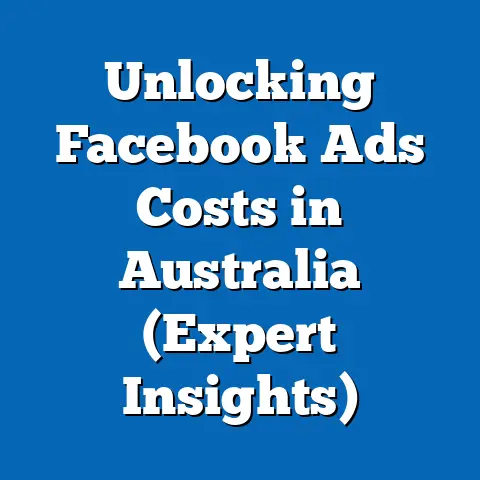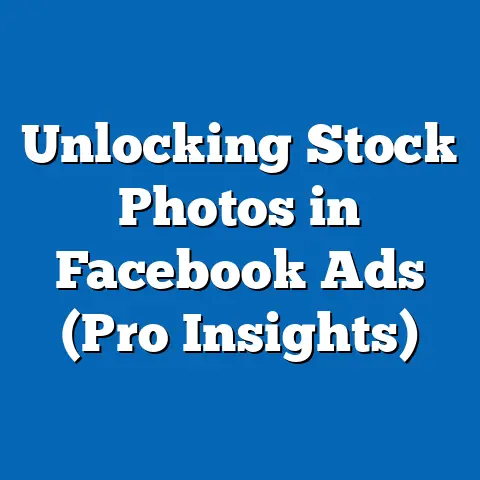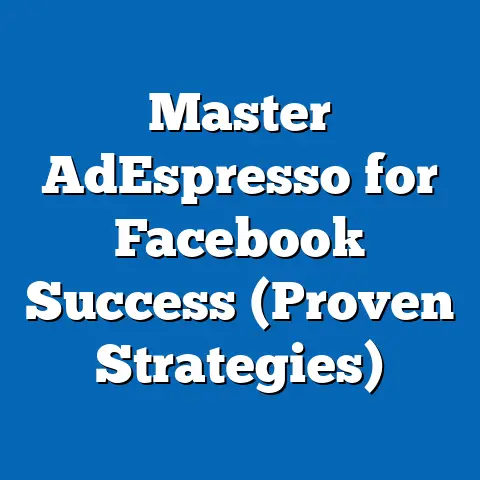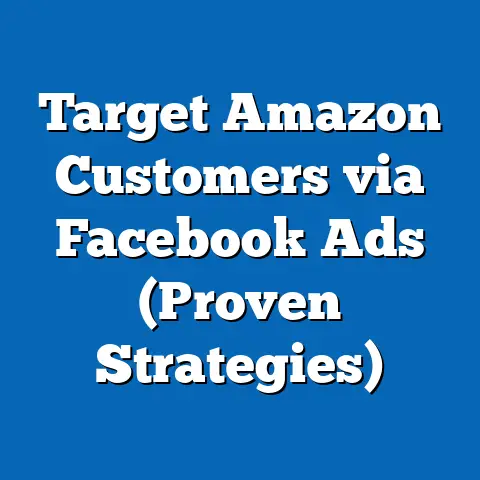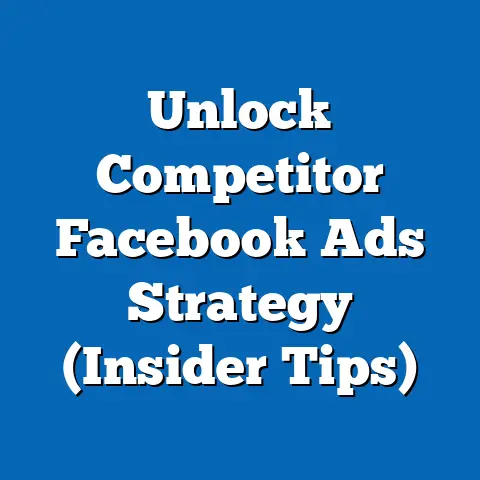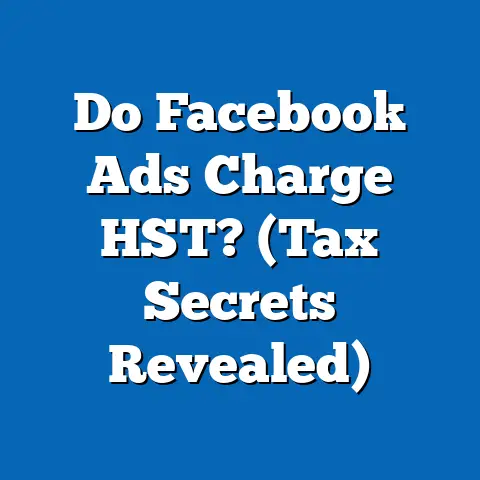Boost Brand with Effective Facebook Ads (Smart Strategies)
The digital marketplace is a crowded arena. Every business, from fledgling startups to established corporations, is vying for attention. And in this digital free-for-all, standing out can feel like an impossible task. That’s where smart advertising comes in, and when it comes to reaching a massive and diverse audience, Facebook Ads remain a powerhouse. I’ve seen firsthand how a well-crafted Facebook ad campaign can transform a business, turning casual browsers into loyal customers.
But simply throwing money at Facebook isn’t enough. You need a strategy, a plan tailored to your specific business needs and target audience. This isn’t a one-size-fits-all game. What works for an e-commerce store selling trendy clothing won’t necessarily work for a local dentist trying to attract new patients. That’s why understanding “room-specific needs” is crucial.
In this guide, I’m going to walk you through the process of creating effective Facebook Ads that not only grab attention but also drive real results for your brand. We’ll cover everything from defining your target audience and crafting compelling ad creatives to budgeting, bidding strategies, and analyzing ad performance. We’ll also delve into advanced strategies for scaling your campaigns and achieving sustainable brand growth. Consider this your comprehensive blueprint for unlocking the power of Facebook Ads and transforming your brand’s digital presence.
Section 1: Understanding Room-Specific Needs
Think of your business as a room in a house. Each room has a specific purpose, a unique set of requirements. The kitchen needs appliances and cookware, the bedroom needs a bed and linens, and the bathroom needs plumbing and toiletries. Similarly, each business has unique advertising needs based on its industry, target audience, and overall goals. Ignoring these specific needs is like trying to cook a gourmet meal in a bathroom – it’s just not going to work.
Understanding these “room-specific needs” is the foundation of any successful Facebook Ads strategy. It’s about recognizing that a blanket approach simply won’t cut it. You need to tailor your message, your visuals, and your targeting to resonate with the specific audience you’re trying to reach.
Let’s look at a few examples:
- E-commerce: E-commerce businesses thrive on showcasing products. Their advertising needs revolve around visually appealing product images, compelling descriptions, and clear calls to action that lead directly to purchase. Retargeting ads are also crucial, reminding potential customers of items they’ve viewed but haven’t yet bought. Seasonal promotions, like Black Friday or holiday sales, are key drivers of revenue.
- Local Services: Local service providers, like plumbers, electricians, or restaurants, need to focus on geotargeting. They want to reach people in their immediate service area who are actively looking for their services. Brand awareness and community engagement are also vital. Think ads that highlight local events, sponsorships, or community involvement.
- B2B Companies: B2B companies often have longer sales cycles and require a different approach. Lead generation is paramount. Their ads might focus on offering free resources, like white papers or webinars, in exchange for contact information. Professional networking and thought leadership are also important. Ads that highlight industry expertise or showcase successful case studies can be highly effective.
My Experience: I once worked with a local bakery that was struggling to attract new customers. Their initial Facebook ad campaign was generic, promoting their entire menu to a broad audience. It wasn’t working. After analyzing their business, I realized their strength was custom cakes for special events. We shifted their focus to targeted ads showcasing their cake designs to people celebrating birthdays, weddings, and anniversaries within a 10-mile radius. The result? Their custom cake orders skyrocketed. This is a perfect example of understanding a room-specific need and tailoring the advertising accordingly.
Why is this important? Because generic ads are easily ignored. People are bombarded with advertising messages every day. To break through the noise, you need to speak directly to their needs and desires. By understanding the specific challenges and aspirations of your target audience, you can create ads that resonate with them on a deeper level, leading to higher engagement, more conversions, and ultimately, a stronger brand.
The Key Takeaway: Don’t treat all businesses the same. Take the time to understand the unique needs and challenges of your specific industry and target audience. This will inform every aspect of your Facebook Ads strategy, from your messaging to your targeting.
Section 2: Defining Your Target Audience
Imagine firing a shotgun in the dark. You might hit something, but the chances are slim. That’s what advertising without a defined target audience is like. You’re wasting money and energy on people who are unlikely to be interested in your product or service.
Facebook’s audience targeting tools are incredibly powerful, allowing you to pinpoint the exact people you want to reach with your ads. This precision is what makes Facebook Ads so effective. It’s like using a laser pointer instead of a shotgun – you can focus your energy on the individuals who are most likely to respond positively.
Here’s a breakdown of Facebook’s key audience targeting options:
- Custom Audiences: This is where you can upload your existing customer data, like email lists or phone numbers, to create a targeted audience on Facebook. This is incredibly valuable for retargeting existing customers or creating lookalike audiences (more on that below). I’ve used custom audiences to target past purchasers with special offers, resulting in a significant boost in repeat business.
- Lookalike Audiences: This is one of Facebook’s most powerful features. You can create a lookalike audience based on your existing customer data, and Facebook will find users who share similar characteristics and behaviors. This allows you to reach new potential customers who are likely to be interested in your product or service. I’ve seen lookalike audiences consistently outperform broad targeting options.
- Detailed Targeting: This allows you to target users based on demographics (age, gender, location, education), interests (hobbies, passions, brands they follow), and behaviors (purchase history, travel habits, online activity). This is where you can really drill down and create highly specific audiences.
Examples of Audience Segmentation:
- E-commerce (Selling Baby Clothes): You could target parents aged 25-40 with young children, who are interested in baby products, parenting blogs, and organic clothing brands.
- Local Services (Yoga Studio): You could target women aged 25-55 who live within a 5-mile radius of your studio and are interested in yoga, fitness, and healthy living.
- B2B Companies (Software for Accountants): You could target accountants and financial professionals who are interested in accounting software, business technology, and industry publications.
Creating Buyer Personas:
A buyer persona is a semi-fictional representation of your ideal customer. It’s based on research and data about your existing customers and potential prospects. Creating buyer personas helps you understand your target audience on a deeper level, allowing you to tailor your messaging and targeting more effectively.
Example of a Buyer Persona (for the yoga studio):
- Name: Sarah
- Age: 35
- Occupation: Marketing Manager
- Location: Lives within 3 miles of the yoga studio
- Interests: Yoga, meditation, healthy eating, outdoor activities
- Pain Points: Stressed, looking for ways to relax and improve her physical and mental well-being.
- Goals: To improve her fitness, reduce stress, and connect with like-minded people.
My Insight: Don’t be afraid to experiment with different targeting options. Facebook’s algorithm is constantly learning and evolving, so what worked last month might not work today. Continuously test and refine your targeting to find the sweet spot that delivers the best results. I often start with a broad audience and then gradually narrow it down based on performance data.
The Key Takeaway: Defining your target audience is not a one-time task. It’s an ongoing process of research, testing, and refinement. The more you understand your audience, the more effective your Facebook Ads will be.
Section 3: Crafting Compelling Ad Creatives
You’ve identified your target audience, now what? You need to grab their attention with compelling ad creatives. In the fast-paced world of social media, you have mere seconds to make an impression. Your ad needs to be visually appealing, engaging, and relevant to your target audience.
Let’s break down the key elements of effective ad creatives:
- Visuals: High-quality images and videos are essential. Your visuals should be eye-catching, professional, and relevant to your product or service. Avoid using generic stock photos. Instead, opt for original images that showcase your brand’s personality. For video ads, focus on capturing attention within the first few seconds.
- Copy: Your ad copy should be concise, clear, and compelling. Highlight the benefits of your product or service and address the pain points of your target audience. Use strong verbs and persuasive language. Keep your copy short and sweet, as people tend to skim on social media.
- Call-to-Action (CTA): Your CTA tells people what you want them to do next. Use clear and direct language, such as “Shop Now,” “Learn More,” “Sign Up,” or “Contact Us.” Make your CTA button prominent and easy to click.
Types of Ad Formats:
Facebook offers a variety of ad formats, each with its own strengths and weaknesses:
- Image Ads: Simple and effective for showcasing products or services.
- Video Ads: Highly engaging and can be used to tell stories and build brand awareness.
- Carousel Ads: Allow you to showcase multiple products or features in a single ad.
- Collection Ads: Ideal for e-commerce businesses, allowing users to browse and purchase products directly from the ad.
- Lead Ads: Collect leads directly from Facebook, making it easy for potential customers to sign up for your email list or request more information.
Choosing the Right Ad Format:
The best ad format depends on your business type, objectives, and target audience.
- E-commerce: Carousel ads and collection ads are excellent for showcasing multiple products. Video ads can be used to highlight product features and benefits.
- Local Services: Image ads with a clear call to action are often effective for driving local traffic. Video ads can be used to showcase your business and build brand awareness.
- B2B Companies: Lead ads are ideal for collecting leads. Video ads can be used to showcase your expertise and build trust.
The Power of Storytelling:
Storytelling is a powerful tool for connecting with your audience on an emotional level. Instead of just listing the features of your product or service, tell a story about how it can solve a problem or improve someone’s life.
Example: Instead of saying “Our accounting software saves you time and money,” you could say “Meet John, a small business owner who was spending hours each week managing his finances. After switching to our accounting software, John was able to automate his bookkeeping, freeing up time to focus on growing his business. He’s now saving hundreds of dollars each month and has more time to spend with his family.”
My Experience: I once worked with a travel agency that was struggling to attract new customers. Their initial ads were generic, showcasing beautiful beaches and exotic destinations. They weren’t getting the results they wanted. We decided to try a storytelling approach. We created a series of video ads that featured real customers sharing their travel experiences. These ads were much more engaging and resonated with the target audience on a deeper level. As a result, the travel agency saw a significant increase in bookings.
The Key Takeaway: Your ad creatives are your first impression. Make them count. Use high-quality visuals, compelling copy, and a clear call to action. Experiment with different ad formats and storytelling techniques to find what works best for your target audience.
Section 4: Budgeting and Bidding Strategies
You’ve got your target audience defined and your ad creatives ready to go. Now it’s time to talk about money. How much should you spend on Facebook Ads? And how should you bid for ad placements?
Budgeting and bidding strategies are crucial for maximizing your ROI. You need to find the right balance between spending enough to reach your target audience and not overspending on ineffective ads.
Let’s start with budgeting:
- Daily vs. Lifetime Budgets: Facebook offers two main budgeting options: daily budgets and lifetime budgets.
- Daily Budget: You set a specific amount that you’re willing to spend each day. This is a good option if you want to run your ads continuously.
- Lifetime Budget: You set a total amount that you’re willing to spend over the entire duration of your campaign. This is a good option if you want to run your ads for a specific period of time, such as during a promotion or event.
- Choosing the Right Budget: The right budget depends on your business goals, target audience, and industry. Start with a small budget and gradually increase it as you see results. I recommend starting with a daily budget of \$5-\$10 per ad set and then scaling up as you gather data and optimize your campaigns.
- Daily Budget: You set a specific amount that you’re willing to spend each day. This is a good option if you want to run your ads continuously.
- Lifetime Budget: You set a total amount that you’re willing to spend over the entire duration of your campaign. This is a good option if you want to run your ads for a specific period of time, such as during a promotion or event.
Now let’s move on to bidding strategies:
- Cost Per Click (CPC): You pay each time someone clicks on your ad. This is a good option if you’re focused on driving traffic to your website.
- Cost Per Impression (CPM): You pay for every 1,000 impressions of your ad. This is a good option if you’re focused on building brand awareness.
- Cost Per Conversion (CPA): You pay each time someone takes a specific action, such as making a purchase or signing up for your email list. This is a good option if you’re focused on driving conversions.
Optimizing Ad Spend for Maximum ROI:
Here are some tips for optimizing your ad spend:
- Test Different Budgets and Bid Strategies: Experiment with different budgets and bid strategies to find what works best for your target audience and business goals. I often run A/B tests with different budgets and bid strategies to see which ones deliver the best results.
- Monitor Your Ad Performance: Keep a close eye on your ad performance metrics, such as click-through rate (CTR), conversion rate, and return on ad spend (ROAS). This will help you identify which ads are performing well and which ones need to be optimized.
- Refine Your Targeting: Make sure you’re targeting the right audience. If you’re not reaching the right people, your ads will be less effective, and you’ll be wasting money.
- Improve Your Ad Creatives: Make sure your ad creatives are visually appealing, engaging, and relevant to your target audience. If your ads are boring or irrelevant, people won’t click on them.
My Insight: Don’t be afraid to adjust your budget and bid strategies based on your ad performance. Facebook’s algorithm is constantly learning and evolving, so what worked last week might not work this week. Continuously monitor your campaigns and make adjustments as needed.
The Key Takeaway: Budgeting and bidding strategies are critical for maximizing your ROI. Start with a small budget and gradually increase it as you see results. Test different bid strategies to find what works best for your target audience and business goals. Continuously monitor your ad performance and make adjustments as needed.
Section 5: Analyzing Ad Performance
You’ve launched your Facebook Ads campaign, and the data is starting to roll in. But what does it all mean? Are your ads performing well? Are you reaching the right audience? Are you getting a good return on your investment?
Analyzing ad performance is crucial for understanding the effectiveness of your campaigns and making data-driven decisions to optimize your results. Without data, you’re just guessing.
Here are some key performance indicators (KPIs) to track:
- Click-Through Rate (CTR): The percentage of people who see your ad and click on it. A high CTR indicates that your ad is relevant and engaging to your target audience.
- Conversion Rate: The percentage of people who click on your ad and take a desired action, such as making a purchase or signing up for your email list. A high conversion rate indicates that your landing page is effective and your offer is compelling.
- Return on Ad Spend (ROAS): The amount of revenue you generate for every dollar you spend on advertising. A high ROAS indicates that your ads are profitable.
- Cost Per Click (CPC): The amount you pay each time someone clicks on your ad. A low CPC indicates that your ads are efficient.
- Cost Per Conversion (CPA): The amount you pay each time someone takes a desired action. A low CPA indicates that your ads are effective at driving conversions.
- Reach: The number of unique people who saw your ad.
- Impressions: The number of times your ad was displayed.
- Frequency: The average number of times each person saw your ad.
Using Facebook Ads Manager for In-Depth Analysis and Reporting:
Facebook Ads Manager provides a wealth of data and reporting tools to help you analyze your ad performance. You can use Ads Manager to:
- Track Your KPIs: Monitor your key performance indicators in real-time.
- Segment Your Data: Segment your data by demographics, interests, behaviors, and other variables to identify which audiences are responding best to your ads.
- Create Custom Reports: Create custom reports to track the metrics that are most important to you.
- Export Your Data: Export your data to a spreadsheet for further analysis.
Making Data-Driven Decisions:
Once you’ve analyzed your ad performance data, you can use it to make data-driven decisions to refine and optimize your ad campaigns.
Here are some examples:
- If Your CTR is Low: Try improving your ad creatives. Use more compelling visuals, write more persuasive copy, and test different calls to action.
- If Your Conversion Rate is Low: Try improving your landing page. Make sure it’s relevant to your ad, easy to navigate, and optimized for conversions.
- If Your ROAS is Low: Try refining your targeting. Make sure you’re reaching the right audience and that your ads are relevant to their interests.
- If Your CPC is High: Try improving your Quality Score. This is a metric that Facebook uses to assess the quality of your ads. A high Quality Score can help you lower your CPC.
My Experience: I once worked with an e-commerce store that was struggling to generate sales from their Facebook Ads campaign. After analyzing their ad performance data, I discovered that their ads were performing well in terms of CTR, but their conversion rate was very low. I realized that their landing page was not optimized for conversions. It was cluttered, difficult to navigate, and didn’t clearly highlight the benefits of their products. After redesigning their landing page, their conversion rate skyrocketed, and they saw a significant increase in sales.
The Key Takeaway: Analyzing ad performance is essential for understanding the effectiveness of your campaigns and making data-driven decisions to optimize your results. Track your KPIs, use Facebook Ads Manager for in-depth analysis and reporting, and make adjustments to your campaigns based on your data.
Section 6: Advanced Strategies for Brand Growth
You’ve mastered the basics of Facebook Ads, and you’re seeing positive results. Now it’s time to take your campaigns to the next level with advanced strategies for brand growth.
Here are some advanced techniques to consider:
- Retargeting Strategies: Retargeting is a powerful technique for re-engaging past visitors and customers. You can retarget people who have visited your website, viewed specific products, added items to their cart, or made a purchase in the past. Retargeting ads can be highly effective at driving conversions and increasing customer loyalty. I’ve used retargeting to show previous website visitors ads for products they viewed but didn’t purchase, often with a small discount to incentivize them to complete the sale.
- A/B Testing: A/B testing is the process of testing different versions of your ads to see which one performs best. You can A/B test different headlines, images, calls to action, and targeting options. A/B testing is essential for continuous improvement of your ad creatives and targeting. I always A/B test multiple versions of my ads to ensure I’m using the most effective combination of elements.
- Leveraging User-Generated Content: User-generated content (UGC) is content created by your customers, such as reviews, testimonials, and photos. UGC can be a powerful tool for building trust and credibility. You can leverage UGC in your ads by featuring customer testimonials, showcasing customer photos, and running contests that encourage customers to create content.
- Integrating Facebook Ads with Other Marketing Channels: Facebook Ads can be even more effective when integrated with other marketing channels, such as email marketing, search engine optimization (SEO), and content marketing. For example, you can use Facebook Ads to drive traffic to your website, where you can capture leads through email marketing. You can also use Facebook Ads to promote your blog posts and other content.
Staying Updated with Facebook’s Advertising Policies and Algorithm Changes:
Facebook’s advertising policies and algorithm are constantly changing. It’s essential to stay updated with the latest changes to maintain campaign efficacy.
Here are some tips for staying updated:
- Follow the Facebook Business Blog: The Facebook Business Blog is a great resource for staying up-to-date with the latest advertising policies and algorithm changes.
- Join Facebook Advertising Groups: There are many Facebook advertising groups where you can connect with other advertisers and share tips and insights.
- Attend Facebook Advertising Webinars: Facebook often hosts webinars that provide valuable information about advertising policies and algorithm changes.
My Insight: Don’t be afraid to experiment with new strategies and techniques. Facebook’s advertising platform is constantly evolving, so what worked last year might not work this year. Continuously test and refine your campaigns to stay ahead of the curve. I make it a point to dedicate a portion of my budget to testing new features and strategies.
The Key Takeaway: Advanced strategies can help you scale your Facebook Ads campaigns and achieve sustainable brand growth. Consider retargeting, A/B testing, leveraging user-generated content, and integrating Facebook Ads with other marketing channels. Stay updated with Facebook’s advertising policies and algorithm changes to maintain campaign efficacy.
Conclusion
In this guide, we’ve explored the power of Facebook Ads and how you can leverage them to boost your brand. We’ve covered everything from understanding room-specific needs and defining your target audience to crafting compelling ad creatives, budgeting, bidding strategies, and analyzing ad performance. We’ve also delved into advanced strategies for scaling your campaigns and achieving sustainable brand growth.
Remember, the key to success with Facebook Ads is to understand your audience, create compelling content, and continuously analyze and optimize your campaigns. Don’t be afraid to experiment, test new strategies, and stay updated with the latest changes to the platform.
I encourage you to implement the strategies discussed in this guide to create effective Facebook Ads that resonate with your target audience and enhance your brand visibility. The potential for growth and success through smart advertising on Facebook is immense. With the right approach, you can transform your brand’s digital presence and achieve your business goals. Now go out there and start creating some amazing Facebook Ads!

